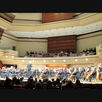Chicago Sinfonietta closes season with Tonal Transformation
- Natalia Dagenhart
- May 1
- 4 min read
The orchestra will perform its season finale May 9 in Naperville and May 10 in Chicago and will feature saxophonist Timothy McAllister.

“The essence of beauty is unity in variety,” said German composer Felix Mendelssohn. The beauty of concerts presented by Chicago Sinfonietta is in the variety of works that Maestro Mei-Ann Chen and the orchestra choose to perform and in the unity of their desire to demonstrate all the aspects of symphonic music. Tonal Transformation will be performed at 7 p.m. on Friday, May 9 at Wentz Concert Hall in Naperville, and at 7 p.m. on Saturday, May 10 at Auditorium Theatre in Chicago.
“Chicago Sinfonietta closes its 37th season with works that are as inspirational and creative as the people who perform them and the audiences for which they are performed,” is noted in the Tonal Transformation booklet. “Having journeyed this season through music celebrating youth, women, culture, heritage, creativity, emotions and more, Chicago Sinfonietta pays tribute to those that allow us to transform our artform for the better.”
The Tonal Transformation concert program will open with the Chicago premiere of a piece called In the Beginning by Brittany J. Green. Brittany is a North Carolina-based composer, performer, and educator. Described as “a creative force of attention-seizing versatility” (The Washington Post) and “cinematic in the best sense” (Chicago Classical Review), Brittany’s music works to facilitate collaborative, intimate musical spaces that ignite visceral responses.
Brittany’s music has been awarded the Alarm Will Sound Matt Marks Impact Fund, American Academy of Arts and Letters’ Charles Ives Scholarship, ASCAP Foundation’s Morton Gould Award, and New Music USA’s Creator Development Grant. She is currently in residence at Duke University, pursuing a Ph.D. in Music Composition as a Deans Graduate Fellow.

“In the Beginning explores the excitement of new worlds forming, colliding, and shifting into place. Legato figures and florid gestures shift throughout the ensemble as soft woodwind and string features juxtapose stately brass and rambunctious percussion,” said Brittany about her composition.
Her work will be followed by Concerto for Alto Saxophone and Strings written by one of the most prolific and distinguished Black American composers of our time, Adolphus Hailstork. He was born in 1941 in Rochester and grew up in Albany, New York. Hailstork first began composing under the encouragement of his high school orchestra director. He received his doctorate in composition from Michigan State University, where he was a student of H. Owen Reed. He had previously studied at the Manhattan School of Music, at the American Institute at Fontainebleau, and at Howard University. Dr. Hailstork has also received honorary doctorates from the Manhattan School of Music and the College of William and Mary. He is professor emeritus at Old Dominion University.

Dr. Hailstork has written numerous works for chorus, solo voice, piano, organ, various chamber ensembles, band, orchestra, and opera. In total, he has written more than 250 compositions.
Chicago Sinfonietta will present the Chicago premiere of his Concerto for Alto Saxophone and Strings. Dr. Hailstork dedicated this composition to Timothy McAllister, “one of the foremost saxophonists of his generation” (The New York Times). According to the Chicago Sinfonietta’s website, “this work is a virtuosic exploration of the saxophone's wide range of tonal colors. With its rich harmonies, intricate melodies, and rhythmic vitality, the concerto offers a captivating journey through an impressive range of emotions and musical landscapes.”
McAllister is today’s most celebrated classical saxophonist and educator. His career in music has taken him to over 20 countries, with solo performances in many of the world’s most prestigious venues including Prince Royal Albert Hall in London, the Sydney Opera House, Carnegie Hall, and Amsterdam’s Concertgebouw. He holds the Doctor of Musical Arts and other degrees in music education, conducting and performance from The University of Michigan School of Music, Theatre and Dance.
Juxtaposing these two modern works is Pyotr Ilyich Tchaikovsky’s deeply colored Symphony No. 4 in F Minor. Pyotr Ilyich Tchaikovsky, one of the most prominent Russian composers of all time, wrote his Symphony No. 4 between 1877 and 1878. As the composer explained in letters, this composition is ultimately a characterization of fate. This work became possible thanks to the composer’s benefactress, Nadezhda von Meck. She was the wealthy widow who sent him a monthly stipend in return for his steady correspondence with her about his music.
“Never yet has any of my orchestral works cost me so much labor, but I’ve never yet felt such love for any of my things.…Perhaps I’m mistaken, but it seems to me that this symphony is better than anything I’ve done so far,” the composer wrote to von Meck.
The work’s famous ominous opening fanfare transitions to a bright energy in the final movement, bringing Chicago Sinfonietta’s season to its conclusion.
For more information and tickets, please go to https://chicagosinfonietta.org/may-2025-tonal-transformation/.
Natalia Dagenhart

























Comments